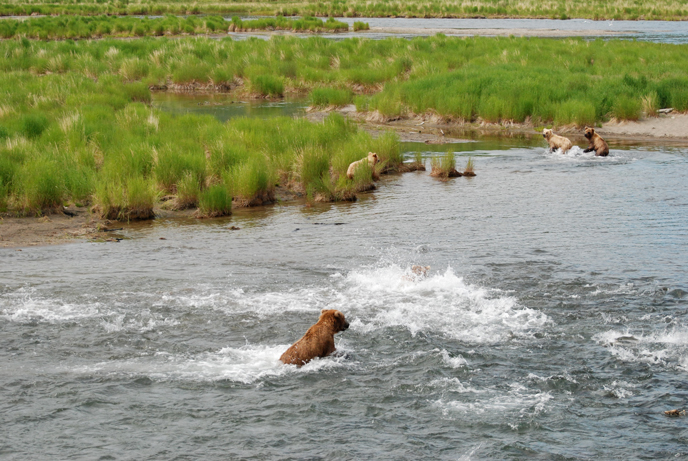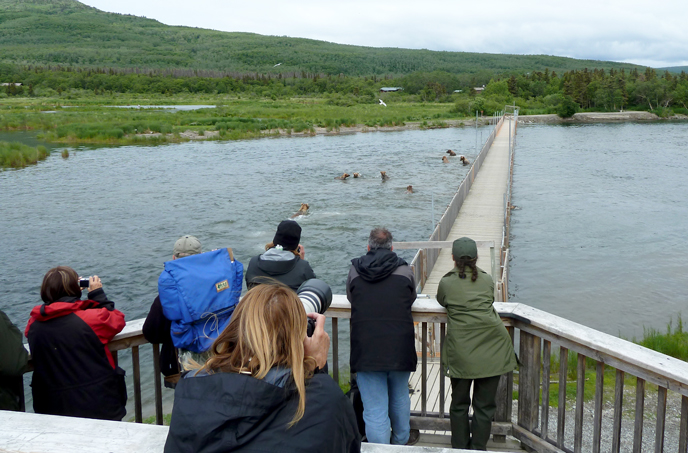
Bears often fish for salmon near the floating bridge at Brooks Camp. For safey considerations and to reduce our potential impact on bears, the bridge is closed when bears are within 50 yards (46 m) of it. When the bridge is closed, you are in a bear jam.
Nine bears can be seen in this bear jam from early July 2010. What were they doing there and what were the circumstances that brought them together? This photo tells a story of hunger, instinct, and survival.
In late June and early July, brown bears at Brooks River are particularly ravenous for salmon. After surviving months of winter hibernation and harsh, starvation conditions in the spring, anything that looks, smells, and sounds like a fish attracts them. The sound of a splashing fish, in particular, started the cascade of events that led to the photo.
Sockeye salmon often move in schools when they first begin to migrate into Brooks River. The first large waves of sockeye usually enter Brooks River in late June. As the fish move upstream, they can mistakenly choose the wrong channel or get pushed by their brethren into shallow water near the river bank or above a submerged gravel bar. Salmon are vulnerable to predation, especially in shallow water. During the initial stages of migration, salmon on the fringe of the school begin to swim frantically. As the salmon in the shallows fight to return to deeper water, they startle other fish. Instinct might tell these others, “That fish is fleeing something. That something might try to eat me. I should move away too.”
In an instant the river is churned into a froth by dozens, and sometimes hundreds, of fish. The water looks like it is boiling. A fish frenzy like this obviously attracts the attention of bears.

Boiling salmon capture the attention of bears. NPS Photo.
On July 7, 2010, I was standing on the wildlife viewing platform near the mouth of Brooks River. Upstream, where the river snakes and disappears, I remember watching salmon boil in the water. I can’t recall whether it was caused by the salmon themselves or a bear chasing them, but I do remember the salmon turning downstream, still boiling, while a bear gave chase.
Splashing fish sounds like food to a bear (a fact that anglers should consider when they are trying to land their fish in Katmai). The sight and sound of the boil caused another bear in the vicinity to take notice. It soon joined the pursuit.
Within a few seconds, another bear appeared on the edge of the river, then another and another. It was though every nearby bear heard the noise and came closer or stood up to investigate. Once these bears realized what was happening, each began sprinting through the water. The escaping fish continued downstream, now pursued by almost ten bears.
Salmon aren’t easy to catch where they have avenues to escape. Fishing for salmon is much more challenging for bears in deeper water. That’s why Brooks Falls is so popular with bears in July—bears can sit and wait for the salmon to come to them. In July, areas of Brooks River downstream of the falls are demonstrably less productive fishing spots, but hunger was driving these bears to take the chance. Perhaps salmon numbers were low in the preceding days. Whatever the exact circumstances it was clear these animals were ravenous. Their need to consume calories was enough motivation.
Soon enough, I watched a wall of bears run downriver driving the fish toward the lake. As the bears approached the bridge, they still hadn’t caught any salmon. Now the water was getting deeper and the salmon weren’t slowing down.
When they got near the bridge, deeper water hindered the bears, but it helped facilitate the salmons’ escape. The salmon swam under the bridge, while the bears splashed in the water near it, almost like they were confused about their prey’s escape. This is when I snapped the photo.
Afterwards, the bears slowly dispersed in various directions—toward the lodge, upriver, and into the forest. It was an event that repeated itself a few times that week, but I had never seen the likes of it before nor have I seen anything quite like it since. Hunger drove the bears to give chase. Escape instincts caused the salmon to flee. This photo, for me, is more than a bunch of bears pouncing in water. It captures a story of hunger, instinct, and survival.
Below: Other views of the bears searching for the meal that got away. NPS/M. Fitz.

